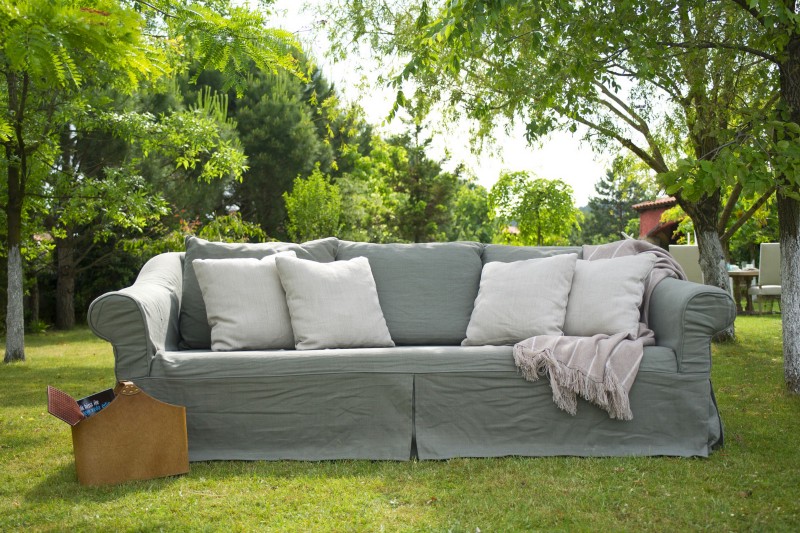
One of the great benefits of working for yourself is the ability to decide where you want to work. Café? Park? Lilo in the pool? Kitchen counter? All viable options. However, most freelancers and entrepreneurs find it useful to have a dedicated homespace to work from, where everything is set up just so to help you get the most from your day. Because even if you like to change it up and work from shared workspaces or coffee shops sometimes, you’ll definitely still need a work-suited space at home. In this post, we look at some research on how the environment affects your mood, thought processes, and productivity, and talk about how you can set up your home workspace so that it works for you.
1) Let there be light

What the science says: Natural light has been proven to be the best for balancing your circadian rhythms, making sure you’re alert and effective during the day, and relaxed and able to get a good night’s rest in the evening.
How to make this work for you: The most obvious answer is to work near a window. Luckily for most homes, this should be pretty easy to achieve. Most kitchens, living rooms, bedrooms, and studies are constructed to make the most of natural light. So, find a corner in any of these rooms, and set up shop.
The important thing to note is that what you want from your window is light, not distractions. So, if you find yourself becoming engrossed in the Epic Battle of Mailman v.s. Neighbour’s Dog, you might want to move your table further away from the window, so that you still get the benefit of light, without the show. A window that looks out onto a garden or other bits of greenery is the best. Nature (plants, grass, blue skies) are great for keeping you relaxed during your work day. Consider planting tall shrubbery outside your window to get the dual benefits of hiding distractions from the road, and getting close to nature.
Also remember that the sun moves during the day, so set up your desk to avoid getting direct glare on your screen or work surface for some bits of the day.
2) Find the ideal room temperature

What the science says: There appears to be an ideal temperature range within which best work happens. This is 21°C — 25 °C or 69.8°F — 77°F. Temperatures well over or under this ‘ideal range’ make most people lose concentration, feel demotivated, make more mistakes, and think slower. However, keep in mind that most of this research focussed on productivity in group settings, using a male of roughly 70 kilograms (154 pounds) as the baseline. Women generally feel the cold more than men, and your own metabolism and overall health will affect how you respond to temperature.
How to make this work for you: Basically, you want to be comfortable while you work. So, if that means 21°C, that’s fine. If you’re always feeling cold and need to set up camp next to the fireplace or heater, that’s fine too. If you overheat and can’t live without the fan or air conditioner, that’s also ok. Just make sure you don’t ignore or underestimate the effects of being too hot or too cold on your productivity.
Also remember that, like light, the temperature in the room will fluctuate over the course of the day as you blast your heater or aircon. So, make sure you do a temperature check on yourself every few hours: no goosebumps or sweat streams? Carry on, mate.
3) Smell your way to success

What the science says: Certain scents can make us more alert, concentrate, and absorb information better, or relax and let go of stress. Peppermint, rosemary, and coffee are great for boosting productivity, while lemon, lavender, and jasmine help you stay relaxed and grounded. Additionally, humans have the ability to learn scents and associate them with certain memories, moods, or cognitive states. Think of how the smell of cinnamon cookies remind you of Nana, or the smell of chalk takes you back to your school days.
How to make this work for you: Try out a few scents in your air diffuser, or get some incense sticks. There’s plenty of research on aromatherapy, so you’ll easily find the right scent that helps you focus, or brainstorm, or get through tedious admin.
You can also try always using one scent in your workspace. For example, by using a particular blend of oils when you’re working, and only when you’re working, your brain will associate that scent with productivity. So, whenever you encounter that smell, your brain will automatically set itself to Work Mode. By combining the principles of Pavlovian conditioning and aromatherapy, you’ll essentially be hacking your brain, programming it to work on demand.
4) Feel comfy

What the science says: Woods, soft textures, and natural fibres feel comforting and warm, while steel, concrete, and glass have the opposite effect. ‘Comfort’ textures in the work environment have been shown to decrease stress, enhance creative thinking, and even improve cooperation between people. And whatever materials you end up choosing, having it all set up ergonomically can spare you a world of pain and health-related problems.
How to make this work for you: Even if you favour ultra minimalistic design in your house, consider adding a few soft touches to your workspace. A shag rug under your feet, a wooden table instead of glass, a throw blanket or cushions that you can snuggle into, will all help. These pleasant tactile sensations keep you comfortable and relaxed, even as you’re crunching deadlines.
And to make sure your posture is correct, and your eyes, neck, back and all the other hardworking bits of you aren’t taking strain, make sure your setup is as ergonomic as possible. The basic principles are simple — you don’t want anything to work more than it has to. So, position your screen at eye level, so you don’t have to pull your neck or eyeballs up or down. Have your keyboard close at hand, and at a height that encourages your arms to rest close to your sides at a 90° angle. Adjust your chair and table height so that your legs are at a comfortable 90°, with your feet resting on that fluffy shag rug. And remember to give your back proper lumbar support with the help of a few cushions. You can achieve good ergonomics with your existing furniture and a few DIY tweaks, but if you want to splurge for a professionally ergonomically designed setup, there are plenty of great (though generally pricy) suppliers out there.
5) Enjoy furry company

What the science says: Having pets around while you work has been shown to improve mood, lower stress, boost morale, and generally increase productivity.
How to make this work for you: Having your furry friend around means you’ll have company throughout the day, someone to talk to (pet owners will attest to this), and someone to help you establish a routine. The important thing is to make sure your workspace is conducive to having a pet around, and that your friend knows you’re working, and isn’t a source of distraction. Your pet should be fully house-trained, so that it’s not barking, scratching, or chewing things up while you’re trying to concentrate. Wires should be kept out of the way, so you don’t lose work when your pet accidentally trips over them. Important papers should be kept off the floor or other surfaces so they’re not walked over. Coffee cups shouldn’t be constantly knocked over etc.
You can also combine the Pomodoro method of working (we discuss this in more detail in this post), with your pet’s exercise requirements. So, work for an hour, take your buddy for a 15 minute walk, then work for another hour. Once you’ve established a routine, your furry friend will be better than an alarm clock for keeping you to your schedule.
Now that you have your home workspace set up with good lighting, comfy furnishings, pleasant scents, and Mr Fluffypants curled up comfortably nearby, head over to Kalido, and find some exciting new work opportunities to crack on with.

